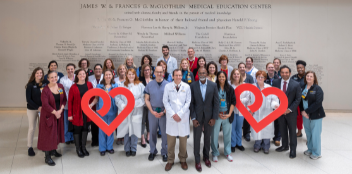MRI technology advances research and patient care
Cardiovascular imaging suite with 3T MRI sets Pauley apart
Compared to most other technologies, MRI produces more accurate images with higher resolution, which has myriad applications, such as cardiac stress testing, the earlier detection of the negative impacts of cancer treatments on the heart and evaluating the effectiveness of cardiac therapies.
One of the biggest advantages of MRI over other imaging technologies is its ability to provide tissue characterization, a determination of which parts of the heart muscle are diseased or healthy. The technology more clearly shows the location of inflammation and scar tissue within the heart muscle.
In 2018, Pauley solidified itself as a leader in the technology by committing $4 million to building its 8,000-square-foot cardiovascular imaging suite, equipped with state-of-the-art 3.0 Tesla MRI scanning and echocardiography. Echocardiography helps physicians and researchers screen for problems, while MRI helps them identify exact problems in high definition.
What sets the 3.0 Tesla scanner apart from traditional models is the strength of the magnetization used to generate images, which leads to more rapidly produced, crisper images, said Cory Trankle, M.D., a Pauley physician and assistant professor in the VCU School of Medicine. Trankle uses the 3.0 Tesla MRI for obtaining images of the heart muscle while patients exercise on an MRI-compatible bicycle. He estimates that only about 20 centers in the world are capable of capturing these quality images.
The MRI technology is also critical to supporting research by Pauley Heart Center director Greg Hundley, M.D., on preventative heart health care for patients undergoing chemotherapy. Hundley was the first in the world to demonstrate that MRI stress testing can identify patients at risk of heart attack. In the clinic’s first year, the number of cardiac MRIs performed at Pauley increased by 95%, preventing at least 87 heart attacks. The three-dimensional images produced by MRI technology are particularly effective at revealing tissue damage caused by a heart attack or compromised blood flow due to arterial blockages.
Back to Spring-2022



